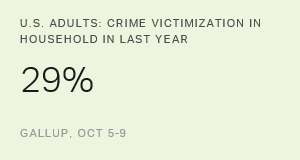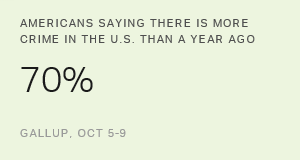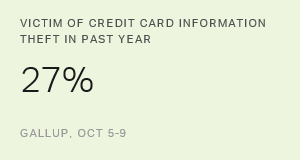Story Highlights
- 29% of U.S. adults indicate household was victimized in past year
- Household victimization up from average 24% in prior decade
- 17% of Americans say they were personally victimized, holding steady
PRINCETON, N.J. -- Twenty-nine percent of U.S. adults report that they or someone in their household was the victim of at least one form of conventional -- meaning nondigital -- crime in the past year. This is in line with the average 27% over the past four years, but up from an average of 24% in the early 2000s.
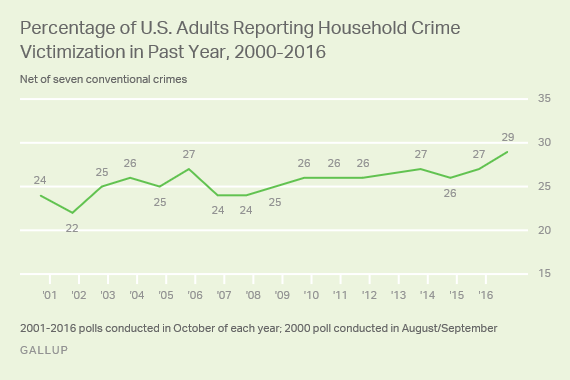
More generally, Americans' self-reported experience with crime has been trending up since about 2001 and is now at a numerical high. Although not significantly higher than the 27% recorded in 2015, it could suggest the continuation of the upward trend and bears watching in the coming years.
The latest results are from Gallup's annual Crime poll, conducted Oct. 5-9.
The household victimization index reflects U.S. adults' responses to whether they or anyone in their household was the victim of each of seven different crimes spanning theft, vandalism and violent crimes. Those who say their household experienced a listed crime are then asked whether it happened to them personally or to another family member.
Overall, 16% of U.S. adults say that they were personally the victim of at least one crime in the past year, similar to the 17% found in 2015 and about the middle of the 14% to 19% range seen since 2001.
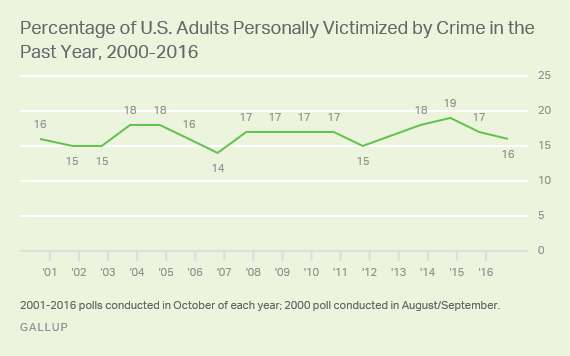
Stolen Property the Most Common Conventional Crime
The conventional crimes that comprise Gallup's crime victimization metrics include four different property crimes and three violent crimes that Gallup has asked about each year since 2000. In terms of the household numbers:
-
17% of Americans say that property or money was stolen from someone in their household in the past year
-
14% report having a home, car or other property vandalized
-
5% say their home was broken into
-
4% say a household member's car was stolen
Smaller proportions of Americans say that a member of their household was a victim of any sort of violent crime in the past year. Of the three types asked about, the most common is a mugging or physical assault (3%), followed by armed robbery (2%) and sexual assault (1%).
The index does not include two types of digital crimes that Gallup began measuring more recently -- experiencing identity theft and having credit card information stolen. More Americans tend to report being victimized by these than by most conventional crimes.
As Gallup reported last month, 27% of Americans say that they or someone in their household had information from a credit card stolen by computer hackers. That is similar to the level in 2014, but up from 22% in 2015. At the same time, 17% say that a household member was the victim of identity theft, similar to 2015 (16%), but significantly higher than the 8% to 12% range seen from 2009 to 2013.
Bottom Line
Americans' direct experience with crime is at a 16-year high, consistent with a gradual increase -- from 22% in 2001 to 29% today -- in the percentage saying that they or a household member was the victim of a robbery, vandalism or violent crime in the past year.
In the same poll, Americans' perceptions of the seriousness of crime nationally and in their local area was unchanged from 2015. But longer term, it has worsened slightly since 2001. As a result, while crime was not at the top of the candidates' or voters' agenda in the 2016 presidential campaign, the issue may be ripe for policymakers at all levels of government to address.
Historical data are available in Gallup Analytics.
Survey Methods
Results for this Gallup poll are based on telephone interviews conducted Oct. 5-9, 2016, with a random sample of 1,017 adults, aged 18 and older, living in all 50 U.S. states and the District of Columbia. For results based on the total sample of national adults, the margin of sampling error is ±4 percentage points at the 95% confidence level. All reported margins of sampling error include computed design effects for weighting.
Each sample of national adults includes a minimum quota of 60% cellphone respondents and 40% landline respondents, with additional minimum quotas by time zone within region. Landline and cellular telephone numbers are selected using random-digit-dial methods.
View complete question responses and trends.
Learn more about how the Gallup Poll Social Series works.
